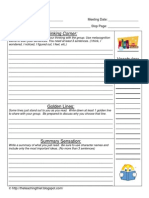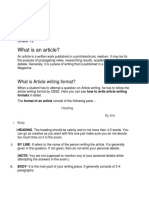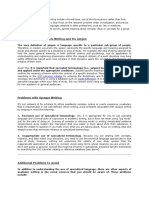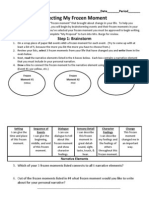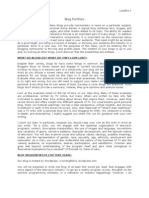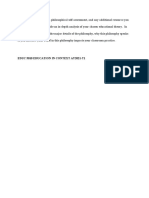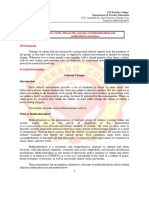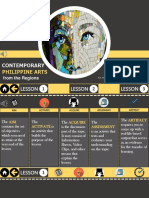Writing Process
Writing Process
Uploaded by
Betiana GamarraCopyright:
Available Formats
Writing Process
Writing Process
Uploaded by
Betiana GamarraCopyright
Available Formats
Share this document
Did you find this document useful?
Is this content inappropriate?
Copyright:
Available Formats
Writing Process
Writing Process
Uploaded by
Betiana GamarraCopyright:
Available Formats
Steps in the Writing Process
1.PREWRI TEexplore the topic and plan your writing; also known as
brainstorming (THINK)
Prewriting is any kind of activity that helps you determine what you will write about. Many
things qualify as prewriting activities. Some of the most common are:
Making lists
Brainstorming
Making webs, charts, clustering, or using graphic organizers
Outlining
Drawing
Discussing the subject
Free writing, journal writing
Note taking
Researching
Interviewing
The purpose of the prewriting stage is to allow you to explore the topic thoroughly in an
informal, relaxed, unstructured way before starting a formal composition. Prewriting is a
prerequisite for good writing. Dont skip this step or cut it short.
2. DRAFTput it down on paper. (WRITE)
Drafting is where formal writing begins. Using your prewriting materials as your guide, you
start to write. At this point, you dont worry too much about mechanics (spelling, punctuation,
etc.), style, or organization. You just want to get your ideas down on paper as quickly and easily
as you can.
You have finished drafting when:
Sketches, notes, outlines, lists or ideas have been turned into sentences and paragraphs.
There is a recognizable beginning, middle, and end.
You have gone as far as you can go without some feedback.
Your draft does not have to be complete from beginning to end. Like prewriting, the drafting
stage is important. It gives you as a writer the opportunity to engage in risk-free exploration of
your subject. Its a good time for trying things out.
3. REVI SEtake a look at what youve written; get some advice.
(MAKE IT BETTER)
Revising means seeing again, and it also includes getting some reader response. Response can
come from many sources:
Teacher conference (show it to your ES)
Peer conference (show it to a friend)
Small group or class share (read it aloud and get some feedback)
Discussion with parent, family members, other adults
At this point, you are looking for reactions and suggestions. Everything is fair game, but
comments regarding conventions should be kept to a minimum. Youll deal with conventions
during EDI TI NG. Right now youre most concerned with your ideas and how well they flow
together into a clear piece of writing.
4. EDI Tmake corrections. (MAKE IT CORRECT)
At this point, the writer will focus formally on mechanical correctness. This is the point in the
process when copy editing occurs. Grammar, usage, punctuation, spelling, and minor changes in
wording are the only work the paper should need at this point.
Editing can come from different sources:
Your ES or another teacher
A friend
Parents
Spell-checking and grammar-checking features on your computer (these are not
foolproof; you still must pay close attention)
5.PUBLI SHpolish your work for presentation, and reflect on it.
(SHARE THE FINISHED PRODUCT)
Publication can take many forms:
Posting at school, publishing in the Voice or on the PCS website
Submitting for formal publication in a newspaper or magazine, or on a website
Reading aloud to an audience
Collecting in a writing portfolio
WRITING A SUMMARY
For Secondary Students
Read with the Writer's Purpose in Mind
Read the article carefully, making no notes or marks and looking only for what the writer
is saying.
After you're finished reading, write down in one sentence the point that is made about the
subject. Then look for the writer's thesis and underline it.
o Does this thesis correspond with the sentence you wrote down? If not, adjust your
sentence or reconsider the thesis you selected.
o Look at the article again and ask yourself if your view is slanted toward one of the
essay's minor points. If it is, adjust your sentence so that it is slanted toward the
writer's major point.
Underline with Summarizing in Mind
Once you clearly understand the writer's major point (or purpose) for writing, read the
article again. This time underline the major points supporting the thesis; these should be
words or phrases here and there rather than complete sentences.
In addition, underline key transitional elements which show how parts are connected.
Omit specific details, examples, description, and unnecessary explanations. Note: you
may need to go through the article twice in order to pick up everything you need.
Write, Revise, and Edit to Ensure the Accuracy and Correctness of Your
Summary
Writing Your Summary
Now begin writing your summary. Start with a sentence naming the writer and article
title and stating the essay's main idea. Then write your summary, omitting nothing
important and striving for overall coherence through appropriate transitions.
Be concise, using coordination and subordination to compress ideas.
Conclude with a final statement reflecting the significance of the article -- not from your
own point of view but from the writer's.
Throughout the summary, do not insert your own opinions or thoughts; instead
summarize what the writer has to say about the subject.
Revising Your Summary
After you've completed a draft, read your summary and check for accuracy.
o Does your summary make the same point as the article?
o Have you omitted anything important?
o Does your summary read smoothly with all parts clearly related?
Keep in mind that a summary should generally be no more than one-fourth the length of
the original. If your summary is too long, cut out words rather than ideas. Then look for
non-essential information and delete it.
Write another draft -- still a draft for revision -- and ask someone to read it critically.
o Can that person understand the sense of the article by reading your summary?
o Ask for criticism; then weigh these criticisms and make valid changes.
Editing Your Summary
Correct grammar, spelling, and punctuation errors, looking particularly for those common
in your writing.
Write a clean draft and proofread for copying errors.
Summary Writing
Summarizing is a very simple concept, but actually doing it can be challenging. It is an excellent
way to polish your thinking skills, since you have to be able to pick out the most important ideas
in something you read and explain them briefly, without adding any unnecessary details.
When you write a summary, you use your own words to explain the main ideas of what you
have read. A summary does not include your opinions. You are trying to convey only what the
writer has said about the subject. Your summary should be much shorter than the passage you
are summarizingabout to as long.
How to write a summary:
1. Read your article or passage and look for the main idea of the whole piece.
2. Read through the piece again, and identify the main idea in each paragraph.
If possible, make a copy of the piece. Then you can highlight or underline to help
yourself identify main ideas.
Asking yourself the 5 Ws can help you: who, what, when, where, why
3. Make yourself a brainstorm in the style that is most helpful to you, such as a word web,
an outline, or a chart. Include:
Author
Title
Source (the title of the book, magazine, or encyclopedia where the piece was
published)
Overall main idea of the entire piece
Subtopics: major points within the piece
4. Begin your first draft. Do not look at the original now; use only the key words and ideas
you wrote on your brainstorm.
5. When you have completed your first draft, go back and read over the piece to make
sure that you included all of the main ideas.
6. Add any main ideas you may have left out, and take out anything youve included that is
not essential. Add transitional expressions to help the individual parts of your summary
flow together.
7. Now its time to revise your work. If you can, share your work with someone else.
Reading it aloud is an excellent way for both you and your listener get a sense of your
work. Have a parent, teacher, or friend read it over and give you some feedbackis
what you have written clear and understandable? Based on your own opinion and the
suggestions of others, make any changes you think necessary. You can add information,
take out information, or just rearrange what youve written so that it flows more
smoothly and makes more sense.
8. After revising comes editing. This is when you focus on the correctness of your writing.
Re-read your writing, and do your best to correct the spelling, punctuation, and
grammar. Then ask for some help from a parent, teacher or friend. You want not only
the ideas in your work to be correct, but also the words with which youve expressed
your ideas.
Transition Words and Phrases
These can help you make your ideas flow together within a paragraph, and they can make your
paragraphs flow together into a piece of writing that will interest and inform your reader.
To show how things are related in time
or to show the order in which theyre related
after
before
first
second
third
later
meanwhile
next
When you want to add information additionally
in addition
for example
furthermore
When you want to bring your writing to a
Conclusion
finally
in conclusion
therefore
When you want to contrast, or show how
things are different
although
on the other hand
yet
conversely
nevertheless
however
When you want to emphasize a point indeed
for this reason
to emphasize
When you want to compare, or show how
things are the same
in the same way
likewise
similarly
You might also like
- Minutes of School Planning Team Meeting: Balo-I Central Elementary SchoolDocument7 pagesMinutes of School Planning Team Meeting: Balo-I Central Elementary SchoolRaima CABARONo ratings yet
- Key Rules of Good WritingDocument38 pagesKey Rules of Good WritingSibghaNo ratings yet
- PWC - Writing Tip Vol2 FinalDocument130 pagesPWC - Writing Tip Vol2 FinalBao NgocNo ratings yet
- Consumer Decision Making Process PDFDocument20 pagesConsumer Decision Making Process PDFarjun149278% (9)
- Research Paper WritingDocument2 pagesResearch Paper WritingommypakNo ratings yet
- 8 Steps To Writing An EssayDocument5 pages8 Steps To Writing An Essayjessa abajeroNo ratings yet
- 10 Tips For An Awesome and SEODocument8 pages10 Tips For An Awesome and SEOEsteban Alejandro SilbaNo ratings yet
- Subject Plus 2010 Synopsis ContentDocument65 pagesSubject Plus 2010 Synopsis ContentVenkateswara Rao SeoNo ratings yet
- Why We FailDocument22 pagesWhy We FailsunilastroNo ratings yet
- Poetry Project LiteraryDocument7 pagesPoetry Project Literaryapi-354411812No ratings yet
- Effective Writing: Learning The Skills To Write Quality PapersDocument21 pagesEffective Writing: Learning The Skills To Write Quality Paperstarabparker1No ratings yet
- 1.how To Write A Good Hook For Your EssayDocument3 pages1.how To Write A Good Hook For Your EssayDavid AgnewNo ratings yet
- Headline Hacks 01 22 2018 PDFDocument69 pagesHeadline Hacks 01 22 2018 PDFPasquale CioffiNo ratings yet
- TSJ v01 I16Document64 pagesTSJ v01 I16Leiway Thar BlogspotNo ratings yet
- How To Be Successful: The Most Important Key To SuccessDocument5 pagesHow To Be Successful: The Most Important Key To SuccessRomán De La RosaNo ratings yet
- 10 Steps To Write A Scientific Paper - A ChecklistDocument18 pages10 Steps To Write A Scientific Paper - A ChecklistMelvin CaldwellNo ratings yet
- 23 Essay Tips To Stand OutDocument27 pages23 Essay Tips To Stand OutAye Myint KyiNo ratings yet
- Book Club Thinking Discussion SheetDocument1 pageBook Club Thinking Discussion Sheetakenda2100% (2)
- 9 Ways Content Curation Will Help Your Brand in 2020Document31 pages9 Ways Content Curation Will Help Your Brand in 2020Farwa AneesNo ratings yet
- How To Be A WriterDocument11 pagesHow To Be A WriterMumtaz Ali BukhariNo ratings yet
- Writing Tips 1Document7 pagesWriting Tips 1THE THIZZNo ratings yet
- 5 Rules For Effective Writing: 11th June, 2007 CategoryDocument14 pages5 Rules For Effective Writing: 11th June, 2007 CategoryAi NaNo ratings yet
- BloggingDocument15 pagesBloggingJeramie BregueraNo ratings yet
- Report in Creative WritingDocument5 pagesReport in Creative WritingCristine Lorete RoblesNo ratings yet
- Business MemoDocument3 pagesBusiness MemoKrishnamoorthy RamakrishnanNo ratings yet
- Writers GuideDocument2 pagesWriters Guidemeow_146No ratings yet
- 16 Easy Ways To Improve Your Writing SkillsDocument16 pages16 Easy Ways To Improve Your Writing Skillsteddy teddyNo ratings yet
- Writing An ArticleDocument11 pagesWriting An ArticleNozima ToirovaNo ratings yet
- Article Writing FormatDocument2 pagesArticle Writing Formatstudygirl03No ratings yet
- Free WritingDocument3 pagesFree WritingMuhammad AqibNo ratings yet
- Blog FinalDocument29 pagesBlog FinalAntoneth AlviolaNo ratings yet
- Self ImprovementDocument5 pagesSelf ImprovementHashir FaheemNo ratings yet
- How To Become A Freelance Writer First Dollar To Six FiguresDocument14 pagesHow To Become A Freelance Writer First Dollar To Six FiguresHashim KhanNo ratings yet
- Self Editing ChecklistDocument2 pagesSelf Editing ChecklistSanjay JoshiNo ratings yet
- Notes & Highlights - How To Read A BookDocument6 pagesNotes & Highlights - How To Read A BookMuntazir BukhariNo ratings yet
- Academic WritingDocument4 pagesAcademic WritingOyon Nur newazNo ratings yet
- The 26 Major Advantages To Reading More Books and Why 3 in 4 People Are Being Shut Out of SuccessDocument11 pagesThe 26 Major Advantages To Reading More Books and Why 3 in 4 People Are Being Shut Out of SuccessRajat GoswamiNo ratings yet
- How To Write A BookDocument12 pagesHow To Write A BookCamilaNo ratings yet
- How To Improve Writing SkillsDocument19 pagesHow To Improve Writing SkillsRieyna AkimNo ratings yet
- Cognitive Model of WritingDocument128 pagesCognitive Model of WritingJohn NewtonNo ratings yet
- Personal Narrative Format 2012Document9 pagesPersonal Narrative Format 2012api-237568148No ratings yet
- Quoting Paraphrasing SummarizingDocument17 pagesQuoting Paraphrasing SummarizingsfsdNo ratings yet
- Emails and MemorandumsDocument10 pagesEmails and MemorandumsUsama EhsanNo ratings yet
- How To Identify Main Points When Reading: Learning DevelopmentDocument2 pagesHow To Identify Main Points When Reading: Learning DevelopmentreiyaNo ratings yet
- 12 Essential Writing Habits For Strengthening Your SkillsDocument2 pages12 Essential Writing Habits For Strengthening Your SkillsAbhishek SharmaNo ratings yet
- Editing and Proofreading PDFDocument2 pagesEditing and Proofreading PDFlalaNo ratings yet
- Extended Writing Workbook (FINAL)Document66 pagesExtended Writing Workbook (FINAL)violet paulNo ratings yet
- Best Poems From The 21st Century: 3 Lessons in How To Write A BookDocument5 pagesBest Poems From The 21st Century: 3 Lessons in How To Write A BookNirvana NircisNo ratings yet
- Writing in Education 73Document68 pagesWriting in Education 73Giulia Longo100% (1)
- Course Reflection English 1301-054Document3 pagesCourse Reflection English 1301-054api-520761590No ratings yet
- Blog PortfolioDocument2 pagesBlog PortfolioDalyn LuedtkeNo ratings yet
- Lecture 4 PPT 1 - Writing ProcessDocument12 pagesLecture 4 PPT 1 - Writing ProcessAreeba ZafarNo ratings yet
- Effective Mechanics of WritingDocument23 pagesEffective Mechanics of Writingumar altafNo ratings yet
- Expository Writing: Self/Peer Checklist: ROUGH DRAFT Due Tuesday, Nov. 19 FINAL DRAFT Due Friday, Nov. 22Document1 pageExpository Writing: Self/Peer Checklist: ROUGH DRAFT Due Tuesday, Nov. 19 FINAL DRAFT Due Friday, Nov. 22Gerald LatayanNo ratings yet
- Job Interviewing Skills Lesson Plan PDFDocument7 pagesJob Interviewing Skills Lesson Plan PDFsatish sNo ratings yet
- Writing SkillsDocument23 pagesWriting SkillsAreeba KhanNo ratings yet
- Study Skills Assignment (Notetaking Strategies)Document8 pagesStudy Skills Assignment (Notetaking Strategies)Saba KiranNo ratings yet
- Analysis of Procrastination by MartialDocument2 pagesAnalysis of Procrastination by Martiala4agarwal0% (1)
- Flexible HoursDocument12 pagesFlexible HoursCamila BronharaNo ratings yet
- Example Narrative Essay With Thesis StatementDocument5 pagesExample Narrative Essay With Thesis Statementhollyschulzgilbert100% (1)
- Simple Steps To Writing, Revising and Editing An Essay: Home Products Demo Store About Mobile Contact Live ChatDocument4 pagesSimple Steps To Writing, Revising and Editing An Essay: Home Products Demo Store About Mobile Contact Live ChatNona KochorashviliNo ratings yet
- Annual Implementation PlanDocument12 pagesAnnual Implementation PlanArLyn NOva100% (6)
- Rohit Chauhan E-MailDocument3 pagesRohit Chauhan E-Mailshakti4itNo ratings yet
- Creating A Writing OutlineDocument2 pagesCreating A Writing OutlineMeth Valladarez TanquisNo ratings yet
- Book - of - IQ - Tests v1Document123 pagesBook - of - IQ - Tests v1xula100% (9)
- How To Write A Methodology For A Masters DissertationDocument7 pagesHow To Write A Methodology For A Masters DissertationWriteMyPaperOnlinePasadenaNo ratings yet
- Educ 5010 Unit 3 Written AssignmentDocument5 pagesEduc 5010 Unit 3 Written AssignmentChifundoh BandaNo ratings yet
- The Obscure Number of DurationDocument46 pagesThe Obscure Number of Durationryvgb4rp4xNo ratings yet
- Gradalitay PDFDocument336 pagesGradalitay PDFOmar RouabhiNo ratings yet
- WAIS-IV Profile of Cognition in SchizophreniaDocument12 pagesWAIS-IV Profile of Cognition in SchizophreniaTheo KhouryNo ratings yet
- Fs Futsal Coaching Workshops: The Full Stop in Everything Related ToDocument3 pagesFs Futsal Coaching Workshops: The Full Stop in Everything Related Toasdffdsa32No ratings yet
- English Lesson Plan Class: 3 Time: 35x2 Minutes Topic: Fruit (I Like Fruit)Document8 pagesEnglish Lesson Plan Class: 3 Time: 35x2 Minutes Topic: Fruit (I Like Fruit)Ummiatun Ma'rufahNo ratings yet
- Intercultural Business CommunicationDocument11 pagesIntercultural Business CommunicationdifianiNo ratings yet
- DLL in Politics and GovernanceDocument18 pagesDLL in Politics and GovernanceJoyce Bianca Lagman100% (11)
- Kousali Resume's 08-10 AfreenDocument4 pagesKousali Resume's 08-10 AfreenKousalimanagementNo ratings yet
- AdvertisingDocument16 pagesAdvertisingSun KambojNo ratings yet
- Edtpa Task 1 Part B Lesson Plans 1Document18 pagesEdtpa Task 1 Part B Lesson Plans 1api-557401872No ratings yet
- Lenar Format LessonDocument2 pagesLenar Format Lessonapi-318297366100% (1)
- Big Picture in Focus: Uloa. Discuss The Concepts of Multiculturalism and Multicultural EducationDocument8 pagesBig Picture in Focus: Uloa. Discuss The Concepts of Multiculturalism and Multicultural Educationcyril glenn jan auditorNo ratings yet
- UH Lesson Plan Template: Payton BurrowsDocument7 pagesUH Lesson Plan Template: Payton BurrowsPayton BurrowsNo ratings yet
- Technology AssessmentDocument6 pagesTechnology AssessmentcpartridgeNo ratings yet
- Artificial IntelligenceDocument2 pagesArtificial Intelligencedipakkhairnar666No ratings yet
- A Framework For PEST Analysis Based On Fuzzy Decision MapsDocument11 pagesA Framework For PEST Analysis Based On Fuzzy Decision MapsJord0202 holakazeNo ratings yet
- Niklas 2016Document11 pagesNiklas 2016Rossifa SandyNo ratings yet
- 399-Article Text-1611-1-10-20220819Document8 pages399-Article Text-1611-1-10-20220819ASRI DEISMAWARANTI 1No ratings yet
- A. in A - 2 Page Response, Please Respond To The Following Prompt. .Document6 pagesA. in A - 2 Page Response, Please Respond To The Following Prompt. .Alfred IntongNo ratings yet
- Philippine Contemporary ArtsDocument8 pagesPhilippine Contemporary ArtsReyes Sabben JerwinNo ratings yet
- Data Science Interview Questions - 365 QuestionsDocument48 pagesData Science Interview Questions - 365 QuestionsAbhay KumarNo ratings yet
- How To Create A Project Risk RegisterDocument8 pagesHow To Create A Project Risk RegisterKL SimNo ratings yet

















